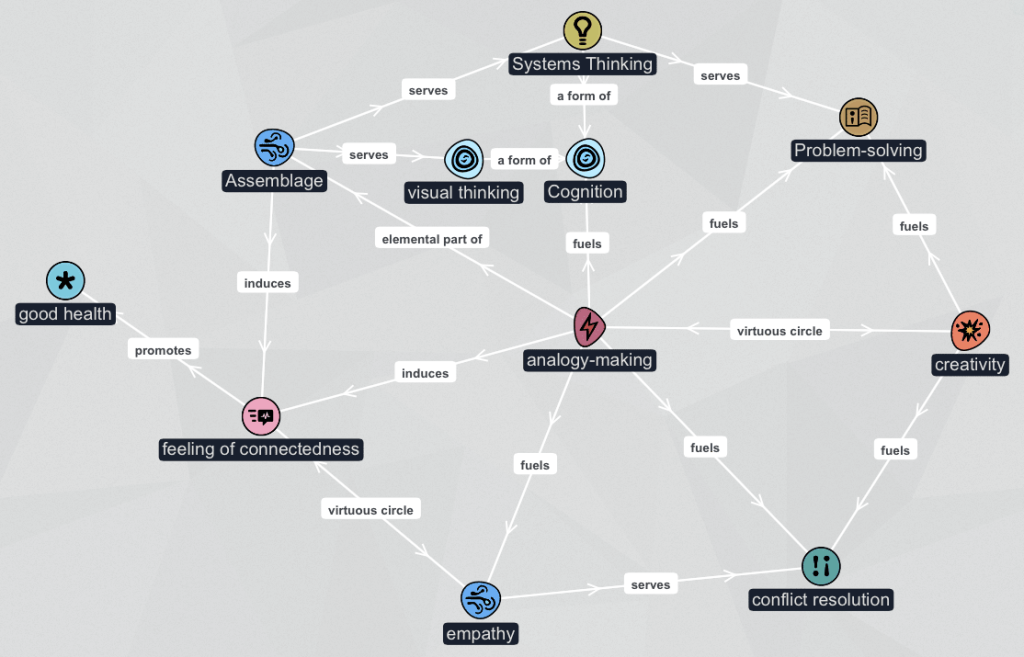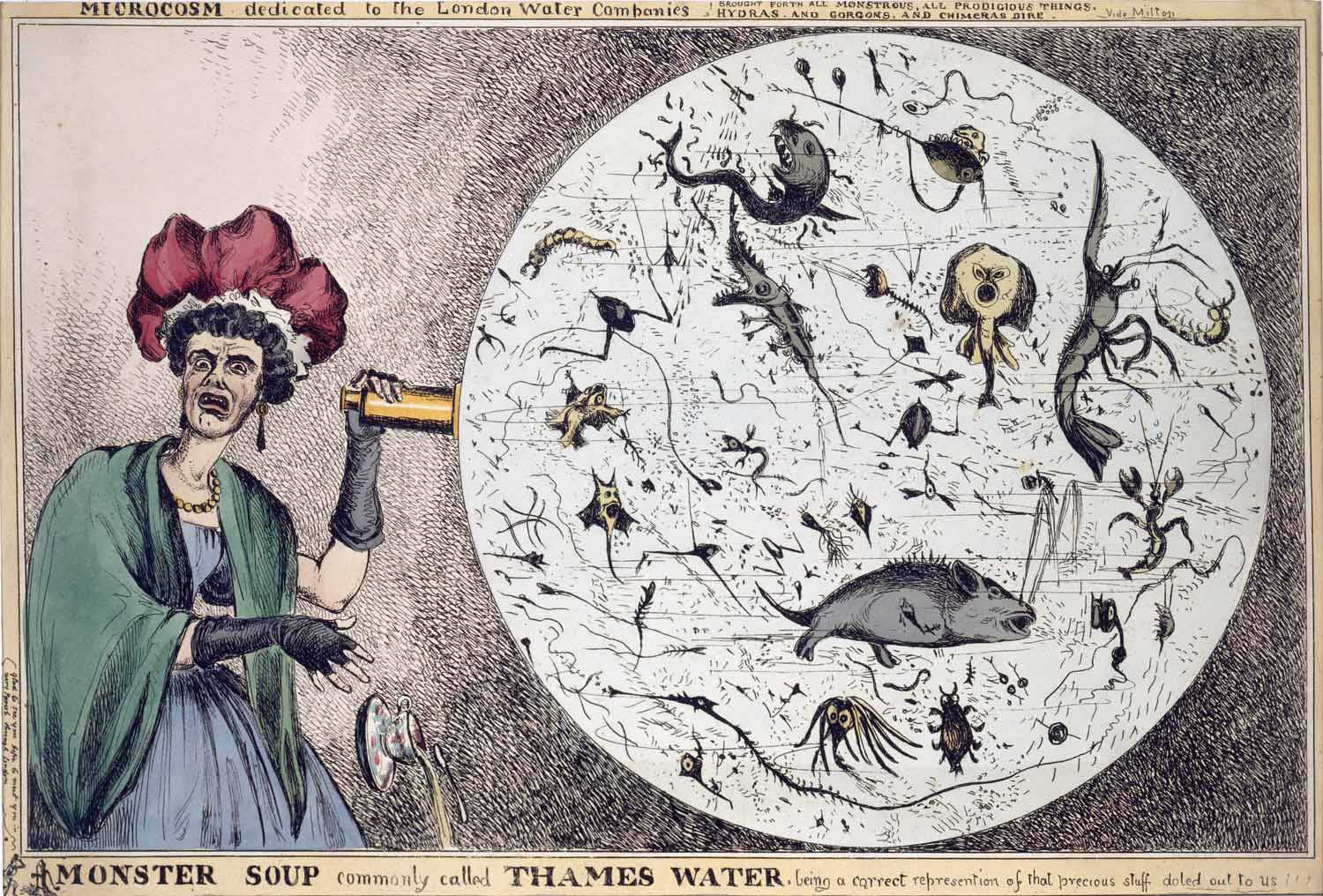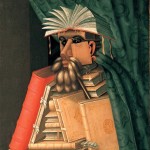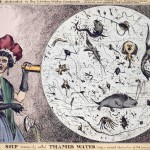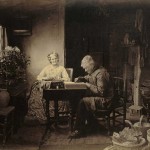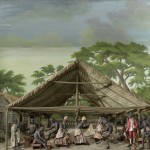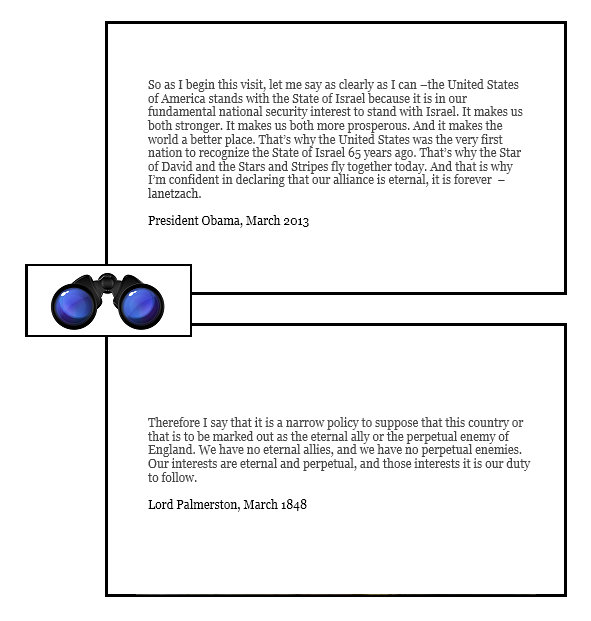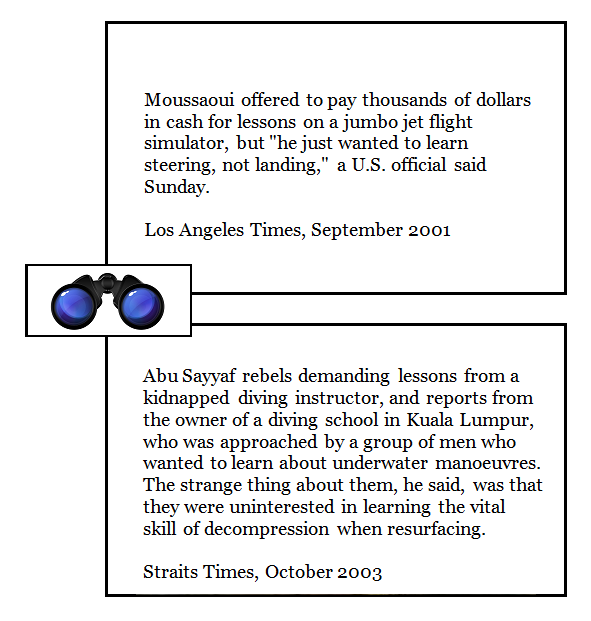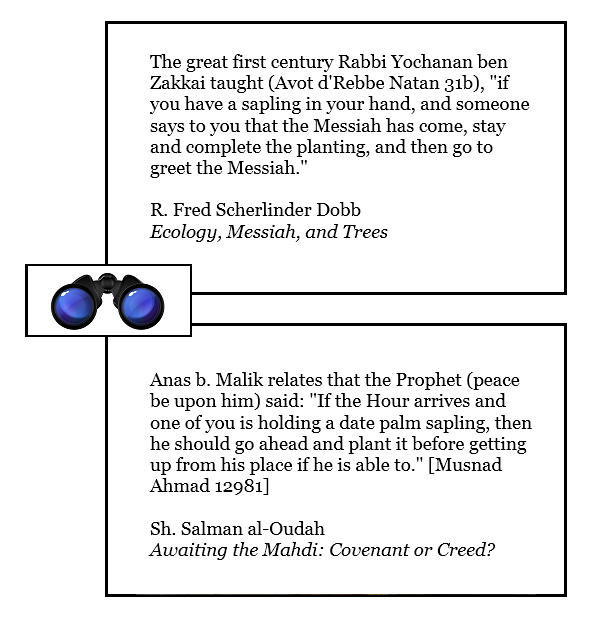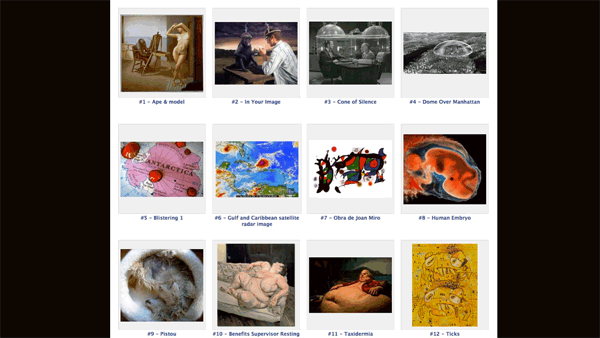On insights gained from Sembl-style thinking
Cousin Metamaps
/0 Comments/in Action & reflection /by CathToiling away on a project like Sembl can be lonely, so I was chuffed this week to make an acquaintance with Metamaps – or more particularly, Ishan Shapiro, one of its founders – and to discover some shared heritage.
Sembl is a descendant of the Glass Bead Game, and its purpose – or one of them – is to foster collaborative sensemaking. In its first form the game aspect of Sembl dominates its role as a sensemaking tool. But part of the reason I adopted this mission to bring Sembl into being was that I’ve been disappointed by every single mindmapping tool I’ve ever tried – because I want to be able to handcraft my own connections between nodes. For me, generic linking is a major limitation of most mindmapping software because the juice of a story is in the quality – and the nuance – of the relationships between the nodes. So my plan for Sembl has always included a de-gamified version, for personal or collaborative non-linear storytelling.
I was pretty excited to discover Metamaps, because it’s almost exactly the mindmapping tool I’ve always wanted. Then – thrill! – I learned that Metamaps was also inspired by the Glass Bead Game. By my reckoning, that makes Sembl and Metamaps cousins :)
Of course, my first exploratory exercise in Metamaps was Sembl-related, mapping the relationship between analogy-making, assembling and cognition, and their effects. Here’s the result:
I’m sharing a static PNG here because I wanted to show it with all the relationships visible. But (assuming you have requested and received access to Metamaps) you can see – and adapt! – the live version on the Metamaps site.
Peace is a bridge
/0 Comments/in Action & reflection /by CathCrafting an entry for the Peace App competition, I came to see the extent to which peace depends on stereophonic thinking – or dialogue in the radical sense deployed by Paulo Freire, David Bohm and so on. It didn’t surprise me – Charles (Sembl’s progenitor) is a kind of peace activist, intervening as he does in the realm of religious violence and global conflict. But for this competition I fine-tuned into the consonance of ‘sembl thinking’ and the project of working for peace and justice.
As it happens Sembl didn’t win, so I here record my thoughts on Sembl and peace-building.
My point may be summed up in the metaphor ‘peace is a bridge’.

Peace is a bridge. Los Angeles County Museum of Art
It’s not as simple as you think. (It seldom is, right?) Partly, the insight is that it’s important to find a way to meet between two opposing sides. In the middle of the bridge you can see both sides equally. That’s the obvious part.
Less obvious but equally important to the peace mission is that when you cross all they way over, you gain a new perspective on where you came from. The kicker is that you don’t actually have to even concentrate, specifically, on the opposing sides, in order to come to new understandings of that conflict, the social structures and historical legacies that fuel it. To foster peace, a bridge doesn’t have to cross the front line; it can go anywhere.
As Charles is wont to say, in Sembl every move is a creative leap. It’s about playing with concepts – diverting your mind in order to come to a some new understanding of what happens in relationships – especially those involving difference or conflict. To illustrate, here are some examples from my recent games:
- The notion that the military is invincible can be used to sell cigarettes and support for war alike; in the context of a Christian culture it draws power from the story of Jesus’ resurrection, fuelling a sense of righteousness.
- Children are always drawn into war – in these examples their food is rationed and they are used to advertise cigarettes for sailors; in real life they are also directly, horrifically, involved – as in the recent Peshawar attack.
- We take care of soldiers, inside and out – as well as all the resources that go into weapons and armour and directly serving warfare, there are plenty more resources deployed to indirectly support it, including the psychological support offered by and required of women and children. What a waste.
- Thinking more broadly about conflict, difference and Otherness, negotiating relationships can be challenging – whether personally, through diplomacy or culturally, through immigration – and in every case, hospitality has its limits.
Aside from any particular insights that this diversionary approach to peace-building generates, as a method it’s a bit magical. For better or worse, most people prefer to be in control of their own learning, to assimilate new information in their own way, if and when and how they like. Presented with a worldview in stark contrast with their own, it’s difficult for anyone to instantly or simply adopt it. And if a peace offering feels disciplinary in any way, it will generate resistance counterproductive to the mission.
Sembl is not pinpointedly concerned with peace and justice, but to my mind – and in my experience – that’s exactly where and how it intervenes. It allows players to find their own way, to build their own bridge.
Game of thrills
/0 Comments/in Action & reflection /by CathHighlights from The Museum Game during last Friday’s Night at the Museum, showing the teams, some crafty connections they made and, of course, who won.
On access and use –> cultural material and Sembl
/0 Comments/in Action & reflection, Design & development, Education /by CathA sample of images already in the Sembl system, and some notes on openness, of both cultural heritage material and of Sembl.
In selecting seed material for Sembl, I look in collections that are:
- openly licensed and
- available to download in high-resolution
with a preference for those that also provide:
- a persistent identifier – to link back from Sembl to the source image, and
- plenty of context – date, place, a description and notes on its significance
I choose images that appeal to me but I also seek out material that matches up with keywords – of people, places, events and concepts – extracted from the Australian Curriculum for History and Geography.
So far there are about 800 images in Sembl. Collections I have tapped are:
- State Library of Victoria (125) – photographs of colonial Victoria, product labels and other illustrations collected as part of the copyrighting process
- Getty Institute open content program (142) – objects, paintings, drawings and sculptures, photographs, botanical illustrations, Greek and Roman material
- National Gallery of Denmark (17) – mostly paintings
- Rijksmuseum (105) – artworks, photographs, objects, a 1635 map showing the edge of Australia, diverse other material
- Walters Art Museum via Stanford University (26) – illustrations from medieval manuscripts
- Wellcome Library, London (159) – World War I photographs, extraordinary illustrations and paintings on health-related topics, John Thomson photographs of 19th-century China, amazing maps, lithographs and engravings
- Wikimedia (3) – two Arcimboldo paintings and Rodin’s The Thinker
- Te Papa Tongarewa Collections Online (52) – World War I photographs, landscape photography and art, some Europen art
- Los Angeles County Museum of Art (119) – Asian art and objects, portraits
No doubt, there is plenty more material available that could be in Sembl. Here are some that I have my eye on:
- material from the Biodiversity Heritage Library – eg Ernst Haeckel illustrations of microscopic organisms – as per the header of this blog
- Paul Gervais’ 1844 Atlas of Zoology
- much, much more from Wikimedia
- more from Te Papa Tongarewa – the number of available images grows steadily
- the Library of Congress
As soon as the games themselves are available (and that will be soon!) the process of selecting material to include in games will also be open. Game hosts and players will be able to upload their own material in advance or as part of a game, so you really will be able to play on any subject or problem you care about. (I’m also very interested to hear of collections you would like to play with, so don’t hold back from commenting or contacting me.)
Quite wonderfully, it seems like every week another museum opens the door to a collection to share its treasure. On a dimmer note, many collections are released with a non-commercial re-use licence, which means (I presume) I would have to seek permission to use them in Sembl. Suffice it to say, I will avoid those for now and hope that repositories find a way to become completely permissive as time goes by.
In the same spirit of optimal openness, I want to share the treasure of Sembl. Here are my thoughts on Sembl as an open platform:
- It will always be free to play against random opponents or at the invitation of a game host.
- The system should work on tablets as well as desktop, and meet AA or AAA accessibility requirements.
- Standard rates for game hosting will be flexible for educators and venues who lack the resources to pay them.
- Sembl data – resemblances between collection items – will be available to source repositories to use in their own databases and interfaces.
- Ultimately, my plan is to make Sembl source code available so that the system can be adapted, refined and extended for the benefit of all patrons.
In between Big Bang and Heat Death
/0 Comments/in Action & reflection, Further afield /by Charles[ cross-posted frpom Zenpundit — a terrific example of the DoubleQuote form, essentially showing a single Sembl resemblance, and thus the smallest form of Sembl game — and why the form is useful ]
.
Some time in between t-zero and t-aleph-null, some time between the First Day of Creation and Judgment Day, some time in between the Big Bang and the Heat Death of the Universe, there’s a stretch of time known as always.
What does juxtaposing the two statements allow us to understand?
- That times have changed?
- That what you tell a foreign government is not what you tell your own?
- That Brits are more understated and Americans more plainspoken?
- That President Obama is showing specific support for Israel, while Palmerston was expressing the general rule which covers all such utterances?
- That the word “always” doesn’t necessarily mean “for ever”, “unto the ages of ages” as the Eastern Church has it?
Perhaps “for the foreseeable future” would be a better phrase to use, if it didn’t sound so iffy. I’d say it means something closer to “in continuity” than to “in perpetuity”.
The great thing about DoubleQuotes as a form is that they jump-start you into thinking about samenesses and differences, without demanding which particular implications you will select, thus giving rise to multiple possibilities and enlarging the scope of narrative or discussion.
And while I’ve sharpened the pairing of quotes — or graphics — into a tool for repeated use, it’s already a habitual form of thinking, as we can see from the fact that these two particular quotes were juxtaposed by Sam Roggeveen in his post, America’s BFF: Obama calls it, in the Lowy Institute’s Interpreter today.
We naturally pair similars to contrast and compare them: it may be the most basic device that human memory affords us — this reminds me of that.
Here are a few of my own old favorites…
You can read Obama’s speech, from which the excerpt above was taken, on this Israel Times page.
Hipbone/Sembl: psychological perspectives
/1 Comment/in Action & reflection, Further afield /by Charles[ a Jungian view, Hipbone/Sembl and the feminine, also an early use of the games in dream-analysis online ]
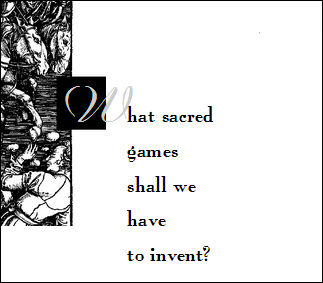 I just received an email from Eve Jackson, an old friend of mine, Jungian analyst and Buddhist practitioner, who has recently been exploring my HipBone Games and expressed her interest in their web-based development as Sembl. One paragraph in particular stood out for me, since it speaks to the issue of the feminine in the games — something I am reluctant to do myself — and also because it emphasizes a central interest and hope of mine, the possible significance of the games in conflict resolution and its expression at the global level of the diversity of cultures:
I just received an email from Eve Jackson, an old friend of mine, Jungian analyst and Buddhist practitioner, who has recently been exploring my HipBone Games and expressed her interest in their web-based development as Sembl. One paragraph in particular stood out for me, since it speaks to the issue of the feminine in the games — something I am reluctant to do myself — and also because it emphasizes a central interest and hope of mine, the possible significance of the games in conflict resolution and its expression at the global level of the diversity of cultures:
Also pleased to read about your friend Cath’s museum game and, especially, the possibility of using the games for conflict resolution. I see the whole thing as having to do with feminine consciousness, which is much needed. Jung emphasises differentiation and the hero archetype in the development of consciousness, hence it tends to be seen by Jungians as a masculine phenomenon, arising from a feminine background of fusion. But consciousness also develops by seeing likeness. Also Jung still lived in a world where one could (and he felt should) work within ones own geographically limited tradition. Now so many strands that had been separated need to be creatively reconnected so the whole complexity can be glimpsed, it can’t be avoided.
I’m very grateful for those words, which express succinctly some of my own key hopes for the game…
Here are the relevant paragraphs of her email in full — personal in part, because each person’s own playing of the game will naturally draw on their own store of images, narratives, quotations etc, but also of that wide significance of which Anais Nin wrote, “The personal, if it is deep enough, becomes universal, mythic, symbolic.” In these paragraphs you will find the personal touching the mythic, and thus giving voice to the universal:
I have been experimenting with your games, drawn back to them by cunning paths of association, and passing the link on to a few likely people. Always remembered the stuff you sent me years ago about Oppenheimer and the Gita which deeply impressed me but got sidelined by the demands of life. Perhaps I feared that such things could be addictive – have always shied away from chess, poker, bridge because I could see them keeping me awake at night.
Now I find myself pleasantly caught. Even got a copy of the Bead Game to reread. Frankly I prefer the hipbone games as less abstract and cerebral than the version Hesse implies, and because there’s a sense in which the Hesse game involves too much labour of consciousness, and even though it can induce satori it risks dryness, lacking the spontaneity/immediacy of hipbone, so that Castalia becomes a sort of severed head. Hesse was clearly aware of this problem himself, hence the relief of Knecht returning to the more natural world, which experience, alas, he can’t sustain. But hipbone is moister, more democratic and more genuinely playful as the unconscious has more free rein. Into my current life in Crete, living with great beauty and blessings in the agony of a disintegrating world, with many levels of occupation and preoccupation, your game has entered as a vivifying current.
Knocked out (not of course for the first time) by the play of the mind, how what is dimly remembered brings with it so much more. For example I moved from the bells of Aberdovey (sound of a drowned world) via Phlebas the Phoenician to Ariel’s song, and was astounded to discover that the song ends with bells. And that Donne’s tolling bell (a further association) follows an image of a clod disintegrating in the sea. And that the bells of Aberdovey are actually alarm bells (waking us from the solutio of sleep). And so on inevitably through the cycle of death and rebirth. These first images also reflect the process itself, the ringing of the Welsh song in my head evoking the underwater world of free-floating associations.
Also pleased to read about your friend Cath’s museum game and, especially, the possibility of using the games for conflict resolution. I see the whole thing as having to do with feminine consciousness, which is much needed. Jung emphasises differentiation and the hero archetype in the development of consciousness, hence it tends to be seen by Jungians as a masculine phenomenon, arising from a feminine background of fusion. But consciousness also develops by seeing likeness. Also Jung still lived in a world where one could (and he felt should) work within ones own geographically limited tradition. Now so many strands that had been separated need to be creatively reconnected so the whole complexity can be glimpsed, it can’t be avoided.
The Game relating to Oppenheimer and the Gita, to which my friend refers, is the solo game titled (after Nietzsche) What sacred games shall we have to invent? downloadable without cost from the Scribd site.
Those paragraphs describe a single human’s use of the Hipbone/Sembl game structure for personal exploration and insight, but this seems the appropriate place to mention that the games have also been used in therapeutic dream analysis. My friend Walter Logeman is a psychotherapist trained in Joseph Moreno’s Psychodrama techniques.
 The “Dream Events” themselves were conducted under conditions of therapeutic privacy, but Walter’s article DreamEvents in Psyberspace, written for the International Association for the Study of Dreams‘s journal, Dream Time, can give readers a detailed sense of how the games actually work in the context of dream symbolism and therapeutic amplification without breaching that temenos.
The “Dream Events” themselves were conducted under conditions of therapeutic privacy, but Walter’s article DreamEvents in Psyberspace, written for the International Association for the Study of Dreams‘s journal, Dream Time, can give readers a detailed sense of how the games actually work in the context of dream symbolism and therapeutic amplification without breaching that temenos.
In introducing Walter’s piece, guest editor Richard Wilkerson raised a question which gets to the heart of the therapeutic possibilities of the games:
How deep can relationships get in an online dream group? Walter Logeman, in DreamEvents in Psyberspace gives sample from a “game” that is played by adults online and creates for several weeks a closed and confidential setting. The game is based on Herman Hesse’s The Bead Game and allows players to make relational moves on a virtual board, connecting dreams, thoughts and feelings in a soulful way.
For myself, the answer to that question is profoundly personal and deeply moving. Stuart, one of the players in the first “Dream Event” which I co-facilitated with Walter Logeman, knew he was in the terminal stages of cancer as he dreamed and discussed and played with us, and at one point he told us how the game felt to him:
I have been thinking about why I am so drawn to what is happening here. It seems to be that this might be a game that consciousness can play with itself irrespective of its containment in a body. A propos pour moi a ce moment
I don’t know that I have ever felt so deeply moved, honored, abashed or humbled by a comment someone else has made about a work I was involved with — but Stuart wrote those words, and I think they reflect pretty accurately just how moving the “Dream Event” indeed was for those who participated.
The HipBone/Sembl games can be played for sheer fun, in friendly rivalry, in formal or informal education, solo or in collaboration, for problem solving, for insight, as meditations or works of art, to facilitate the therapeutic understanding of the self and others, in the analysis of complex, multi-stakeholder and multi-disciplinary situations, and in conflict resolution…
I am very hopeful that Cath’s work on the funding and development of the Sembl games will soon bring us a free, open source, web based version of Sembl — not just for my own delight, but also and particularly for the sake of those others who, like Stuart, can find in these games a profound depth of insight and healing.
Sembl, the game of resemblance: presentation to NDF2012
/3 Comments/in Action & reflection, Design & development, Education /by CathThis post is a web translation of my presentation to the National Digital Forum, Wellington, NZ, on 20 November 2012. (Video recording is here.)
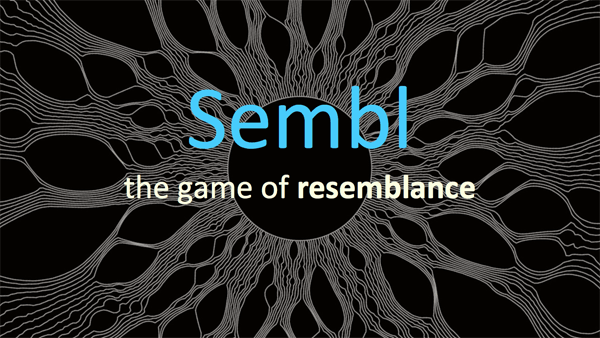
Hello, people. Thank you for having me on this land and at this forum. I’m utterly thrilled to be here – among you all – to talk about this project.
In its first form, Sembl is an iPad game, called The Museum Game, at the National Museum of Australia. We’ve just released it in beta as a program for visiting groups.
This video is a good way to explain how the game works. (It’s a DIY first attempt, so please look past the production quality and focus on the content.)
Feedback
Over the last year and a bit we’ve gathered feedback from children and adults about their experience of playing the game.
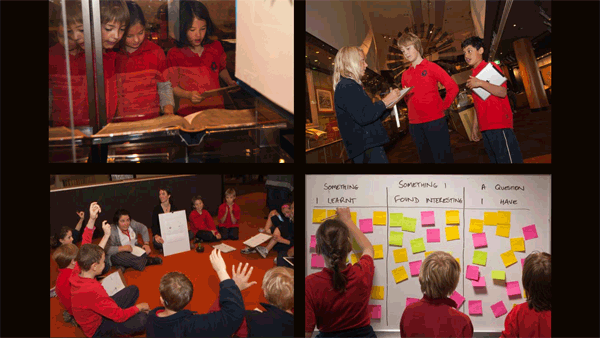
In our first tests, we used a paper prototype; these kids used iPads to take photographs, but the board was paper, and they drew and wrote their moves on paper. Between rounds we had an analogue voting process to determine which team’s content made it onto the board. After the game, we prompted them to tell us a few things about their experience.
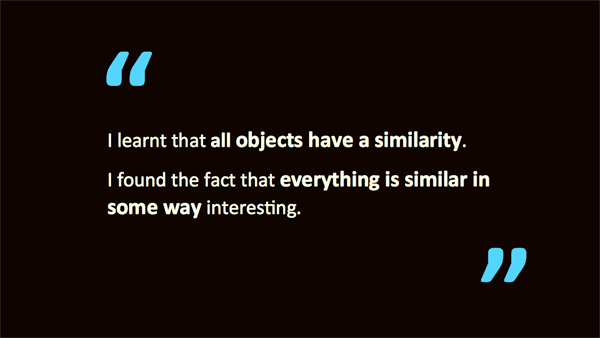
Several kids homed in on the principle of resemblance.
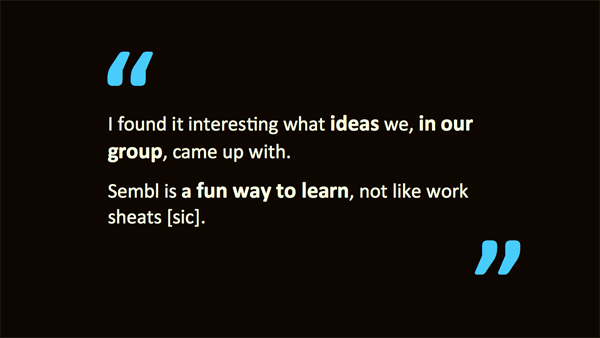
Others emphasised the social side of the game.
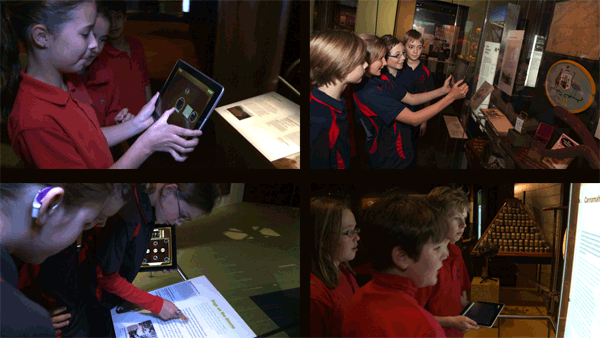
Once we had a digital prototype, we invited the same group back. Again, after the game, we asked them for feedback. The next slide shows some of their responses to the question: What interested you about the game?
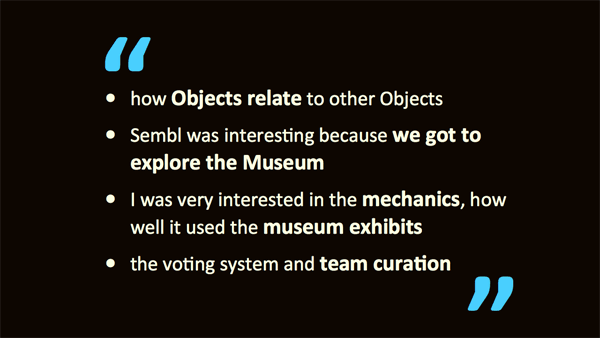
Again, there was general interest in resemblance. But the kids are now also talking about being keen to explore the Museum, how the game used the exhibits, and democratic social curation.
I find that fascinating. You might imagine that looking at a museum through a tablet computer would detract from the authenticity of the visiting experience. But for these kids, it seems like it actually draws them in.
Education
We also interviewed the teacher of those kids; she’s convinced of the value of the game for education.
(Here’s a longer extract of the interview.)
Play
Sembl provides a new way to connect to cultural heritage. It’s about play, which is not just for kids. It’s actually a powerful mode of thought, that we lose touch with as we grow up.
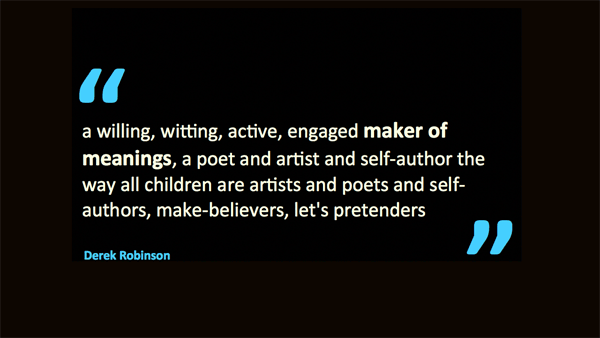
As a smart friend of mine says, we all need to recognise ourselves as a maker of meanings and engage in imaginative play. In this next clip, you’ll see a boy whose first language is not English, and historian Peter Stanley, both moving their bodies and struggling with words as they play.
The game gives visitors permission to let their minds wander, to make new kinds of connections, to think differently.
For the host institution, The Museum Game involves a kind of radical trust, and open authority – recognition that knowledge and understanding is not all about curatorial interpretation, that it also comes from visitors thinking and imagining and sharing ideas with each other. Which remains rare in museums, despite the fact that it makes the experience more compelling for visitors.
Dialogue
Another way of saying this is that the Game provides a structure and impetus for dialogue, between the museum and visitors, between visitors and things, among visitors and between things. And this is not dialogue in the sense of an everyday conversation. It’s deeper than that. It’s a mutual experience of looking both ways, simultaneously.
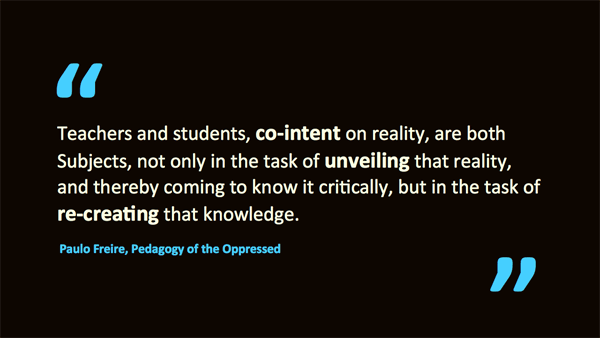
My notion of dialogue comes from the Brazilian educator, Paulo Freire, and his sense of teachers and students as mutually co-intent on creating knowledge.
Quantum physicist David Bohm was also a strong advocate for dialogue.
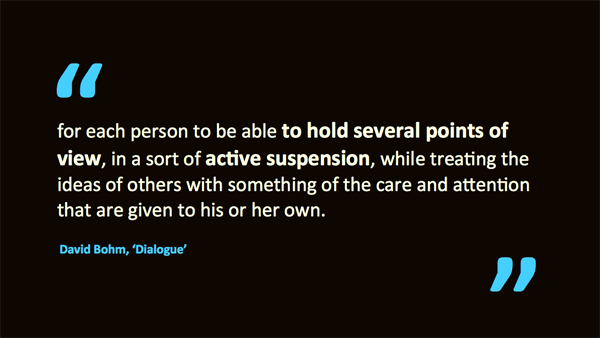
Each of these notions of dialogue is premised on an understanding of consciousness and how thoughts shape reality. For Bohm, dialogue means holding several points of view in active suspension. He regarded this kind of dialogue as critical in order to investigate the crises facing society. He saw it as a way to liberate creativity to find solutions.
Game-based social learning
So the concept of Sembl, in its deepest sense, is social learning – game-based social learning. In its first instantiation, it is game-based social learning in a museum and – if things turn out as I hope they will – from next year it will be playable at any other exhibiting venue that has the infrastructure and the will to host games – galleries, libraries, botanic gardens, zoos and so on.
But The Museum Game is just one form of Sembl. The Museum Game is played in real time, on site, and players take photos of physical objects to create nodes on the board.
The next step is to make a web-based form, that you could play at your own pace, and from your own place. Then, Sembl becomes a game-based social learning network, which amplifies the personal value of the game – it becomes social networking with cognitive benefits.
Personal value aside, it’s the bigger picture – of humans as a community – that I most want to explore: Sembl as an engine of networked ideas, or linked data. First, though, a brief diversion to the genealogy of the game.
Genealogy
I didn’t invent it! The progenitor for Sembl is a vagabond monk called Charles Cameron.
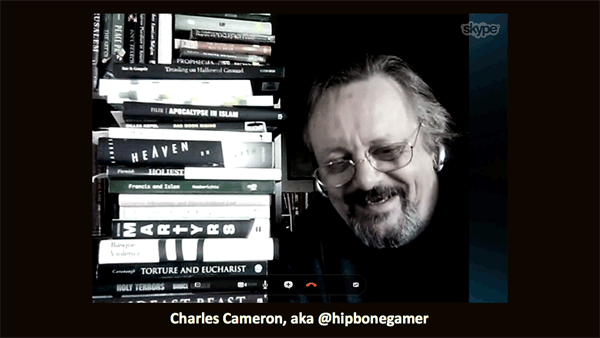
I’ve never met Charles in person but we’ve spoken a lot over the internet, which is how I took this picture. For 15+ years, Charles has been playing what until recently he called Hipbone Games – because the hipbone’s connected to the legbone. He has always played with a static image of a board, through discussion among players, either face-to-face or online.
And Charles crafts whole symphonies of resemblance about war and religion, art and science.

Here’s a classic simple move he made, linking the word-concepts ‘womb’ and ‘tomb’. Charles didn’t invent the game either. Well, not really.
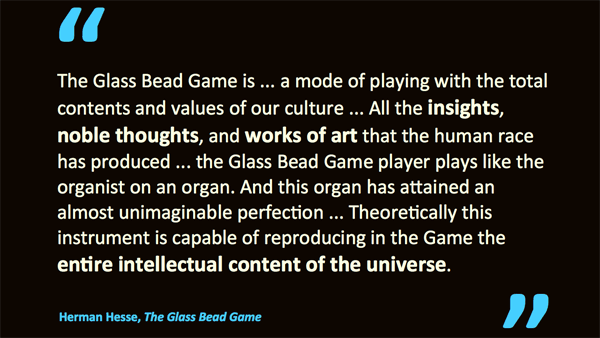
He got the idea from a novel Herman Hesse wrote in the 1940s, called The Glass Bead Game, which as you can see, has a fairly grand vision for the game, to create a kind of music from the entire intellectual content of the universe.
I first encountered Hipbone Games about eight years ago and straight away imagined a digital form, where you could see the network of linked nodes assembling as you play. Ever since then, I’ve been waiting for it to come out in digital… Well, I got tired of waiting, so at some point I adopted it as a personal mission.
Kudos to the National Museum of Australia for building the first digital version. The Museum Game is a simple version of what Sembl can be, but it has potential to grow – and actually, it’s already a little more evolved than it appears in the video at the beginning.
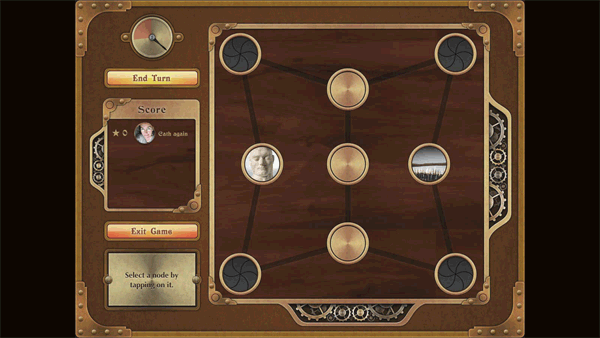
For example, this is the board you saw in the video. We use that one for younger players. But we have other boards, for groups of three teams, for older groups of four teams, for five teams and six.
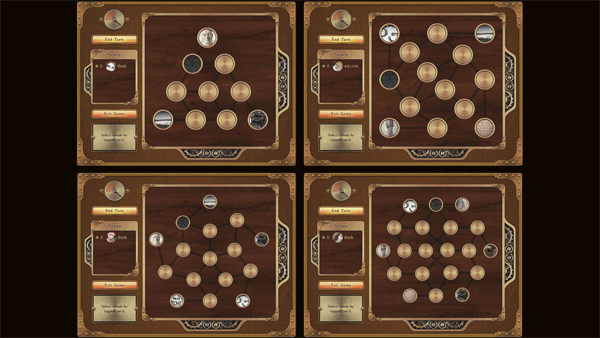
And in the true spirit of the Glass Bead Game, there’s also talk of hosting tournaments at the Museum.
Toward a game-based social learning network
But it’s at the point of networking the gameplay and the game content that Sembl will really ‘level up’ and rock the world. Once the games are on the web, and the field of playable content is already digital, good things can happen:
- We can aggregate game-generated data and build an interface to the ever-evolving web of resemblance. So it’s not just the thought-riffing in your own game you can enjoy, but the whole generative symphony.
- We can preserve links to the objects’ context in online collections, improving their discoverability – and our knowledge and understanding.
- And – if we harvest the associations to display on the museum’s or other sites – we can forge new browseways within and between collections.
In short, the game becomes an engine of rich, useful data about collection material, and through that the world.
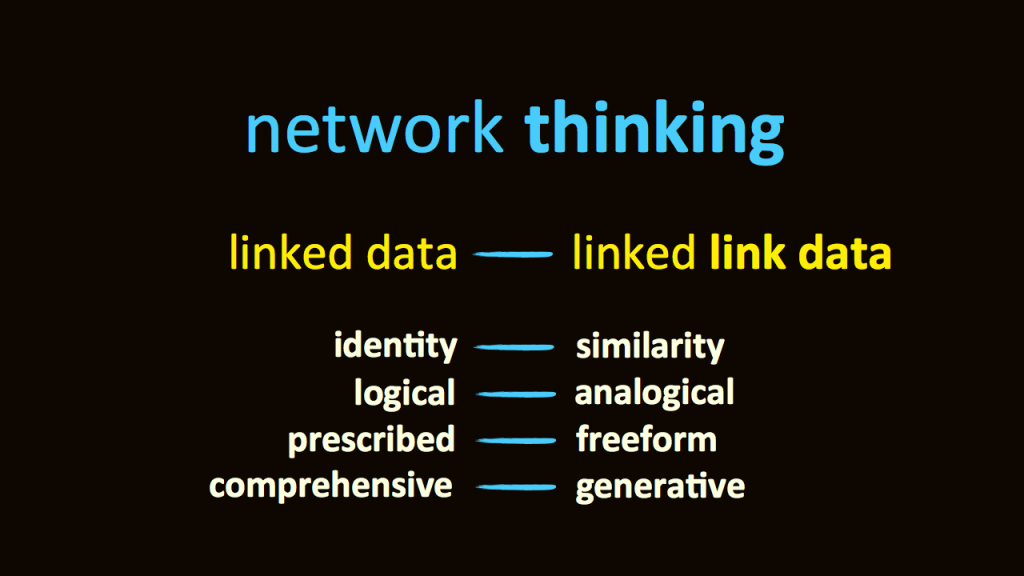
A web-based form of Sembl can generate linked data with a difference. It’s linked link data, and quite different to normal linked data.
- Instead of connections based on what a thing is – sculpture, or wooden, or red – Sembl generates connections based on a mutual resemblance between two things. Which, amazingly enough, is a great way of gaining a sense of what each thing is. And if your interest is to enable joyful journeying through cultural ideas, or serendipitous discovery, this approach just wins…
- Instead of compiling logical links, Sembl cultivates the analogical.
- Instead of building and deploying a structured, consistent set of relationships, Sembl revels in personal, imprecise, one-of-a-kind, free association, however crazy.
- Instead of attempting to create a comprehensive and stable map of language and culture, Sembl links are perpetually generative, celebrating the organic, dynamic quirks of cognitive and natural processes.
But the most important way that Sembl is distinct from other systems of network links is that those who generate the links learn network thinking. Which is a critical faculty in this complex time between times, as many smart people will tell you.
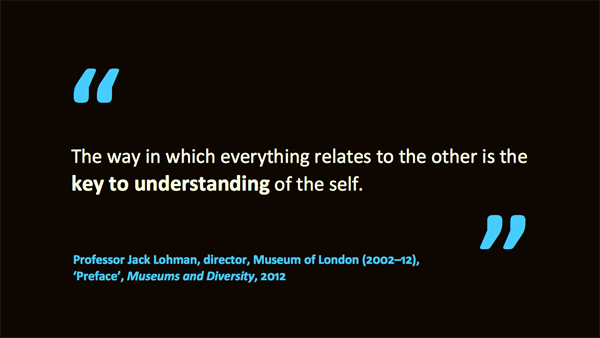
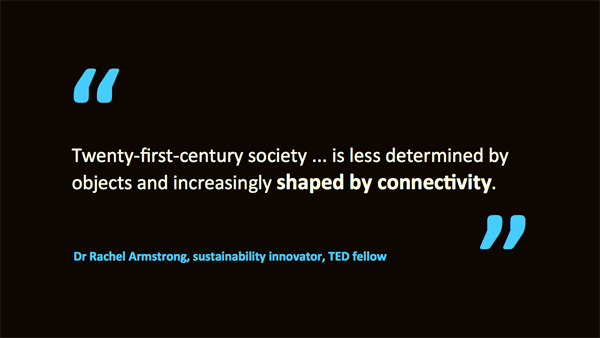
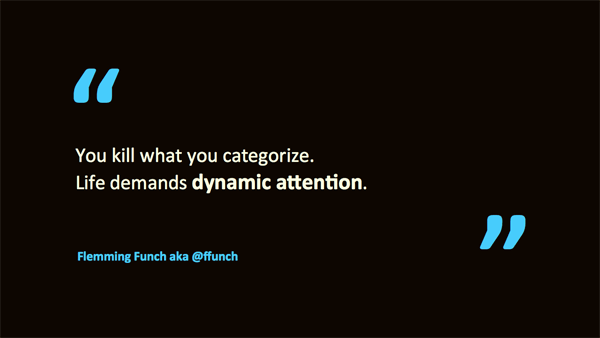
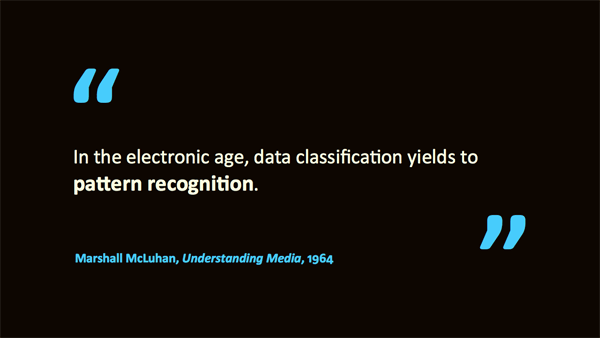
Marshall McLuhan foresaw this shift 50 years ago. Classification is for simple, neat systems. Networks are complex and messy; they demand new forms of literacy. But we have not yet adapted as we need to.
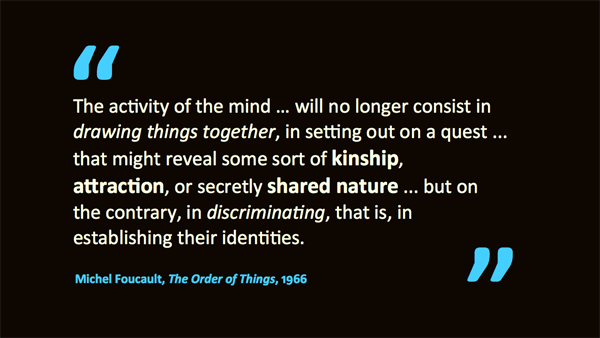
We’re still largely stuck in the Enlightenment thinking that began 400 years ago to institute the binary order of things. But notice what preceded 17th-century ways of knowing. According to Foucault, the ‘primary form of knowledge’ was … resemblance.
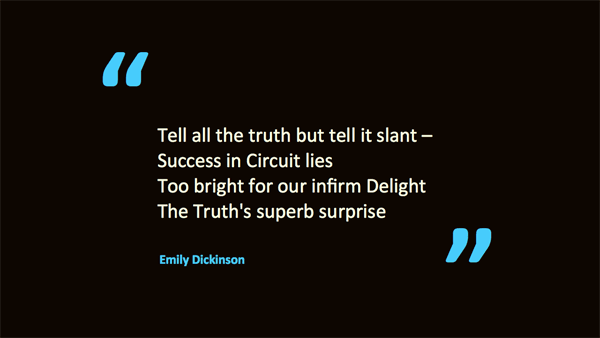
Poets have always known the virtues of analogy as a path to the truth.
And my favourite visual artists work in this way, creating in-between spaces for us to explore and discover.
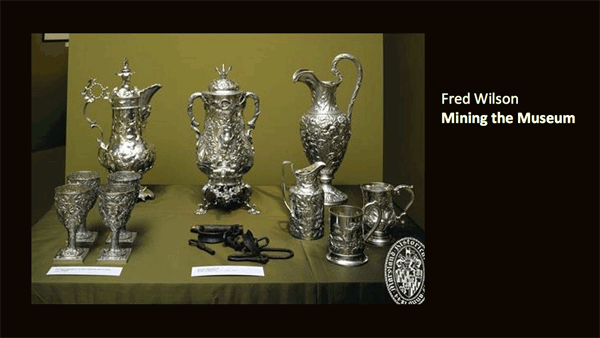
As part of an installation at the Maryland Historical Society, African-American artist Fred Wilson placed a set of slave shackles into a cabinet with fine silverware and called it ‘Metalwork’.
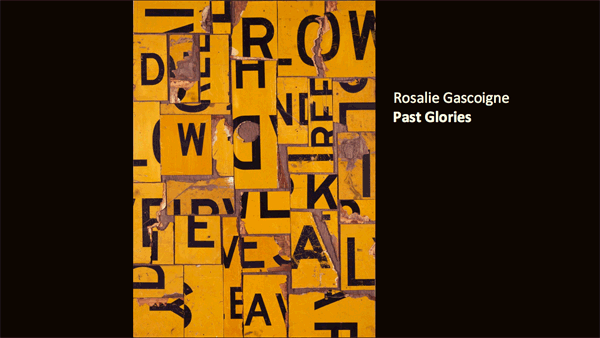
And more subtly, this work is by New Zealand-born artist Rosalie Gascoigne, who lived for a long time in Canberra, where I’m from – so I had to include her… She took discarded signs, disassembled and reassembled them, converting text to textures into which we can read our own messages.
I like the way these artists work; I like how their works induce me to think.
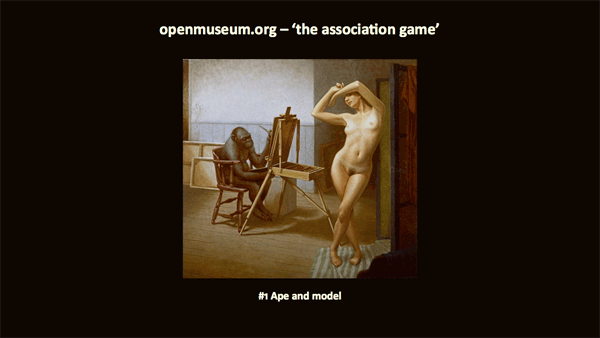
I keep an eye out for opportunities to participate in associative thinking. Last year The Open Museum – a user-generated exhibit site – hosted several rounds of a game where one person would post an initial work, such as this one…
and then anyone else could come along and a post a visually similar work. After a few days the most up-voted work would win the place as the number 2 image, and so on. You can see here how this game progressed in the first 12 moves.
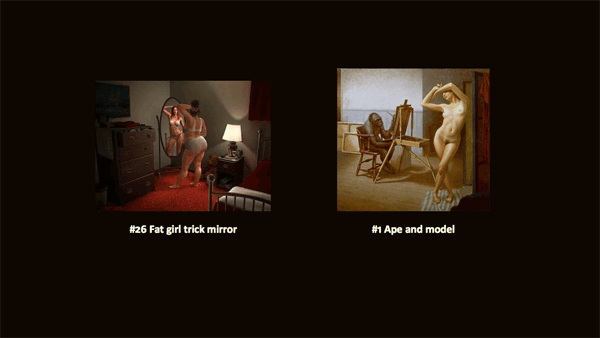
It continued until after 26 moves, it looped back to the original work.
Brilliant. I love how there’s no right answer, and that it encourages wide and wild associations – from a satellite image to a Miro, to a photo of a human embryo.
Polyphonic thinking
Sembl promotes dialogic, non-linear thinking, and new forms of coherence.
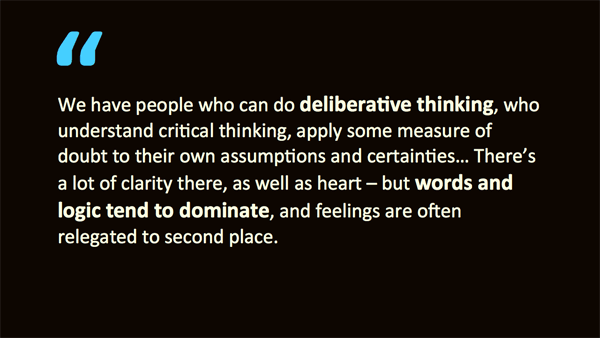
It’s distinct from deliberative thinking, which is rational and causal and logical and linear.
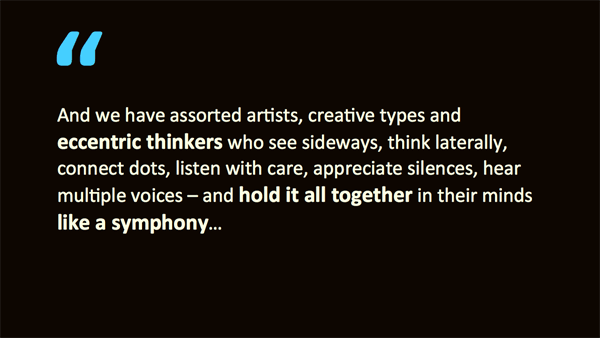
It’s another kind of thinking, which might be informed by rational thought, but its purpose is not singular.
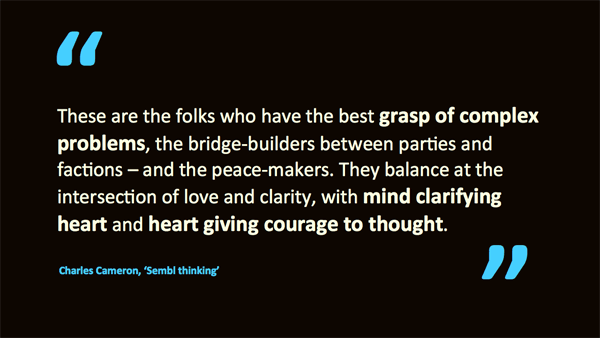
You might say its purpose is to create – and cohabit – a state of grace, from which ideas simply emerge.
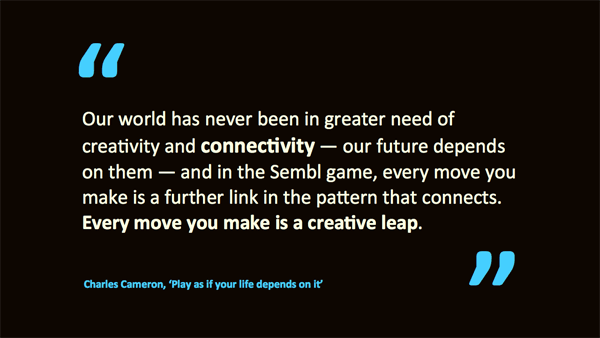
If playing Sembl gives us practice in polyphonic thinking, if it helps cultivate connectivity and our capacity to find solutions to local and global problems, it is good value. As Charles says, every move is a creative leap.
If you’re interested in working with us to supply content, develop strategy or raise capital, we’re keen to talk.
And I can’t tell you how much I’m anticipating being able to invite everyone to play.
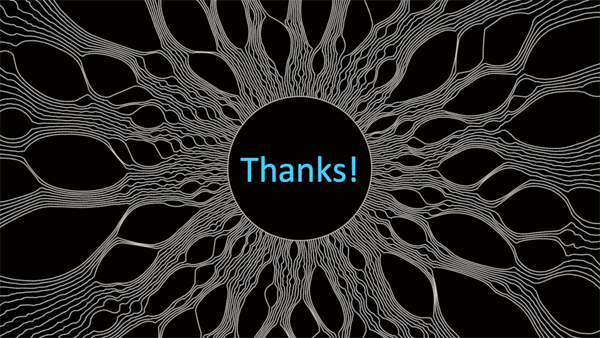
*****
NDF delegates were a truly lovely audience. Having spoken with lots of people about Sembl in the past week – and now that I have a bit of distance from this presentation – I can already see some ways in which I could express Sembl ideas in more pithy, accessible ways. In fact, I plan to rewrite the home page of this site.
In the mean time, know that I would absolutely more-than-welcome further comments, ideas, questions or – of course – resonances with your own context. And if you want to help shape Sembl, you could tell me: in what way are these ideas useful to you, personally and/or professionally? (Or to put this another way: how might you use a tool for network thinking?)
Sembl @ NDF2012
/0 Comments/in Action & reflection /by Cath-
So I remember what people said, I’ve compiled tweets about my presentation on Sembl to the National Digital Forum in Wellington on 20 November 2012.
-
It starts with announcements and descriptions…
-
Sembl – explore the world thru resemblance #ndf2012
— Mike White (@AstronomyMike)
6 days ago -
http://Sembl.net #ndf2012
— Mike White (@AstronomyMike)
6 days ago -
Now learning about Museum game, Sembl, from @cathstyles "sometimes really weird things still have one thing in common" #ndf2012
— APNK (@PeepsNetwork)
6 days ago -
Digital technology as a gateway to physical objects in a museum. Creating dialog btwn people, museum & things. http://www.nma.gov.au/education-kids/game #NDF2012
— Shannon Simpson (@delsim)
6 days ago -
Sembl allows users to create their own context & connections from their experiences for understanding museum artifacts. #ndf2012
— Shannon Simpson (@delsim)
6 days ago -
#ndf2012 Democratic social creation and leaning playfully @CathStyles on the Sembl game. More here http://catherinestyles.com/category/sembl/
— Eleanor Whitworth (@elewhitworth)
6 days ago -
@cathstyles exploiting propinquity and intersticity for pedagogical purposes and making it fun #NDF2012 #Sembl
— Stephanie Pride (@StephaniePride)
6 days ago -
Then comes the enthusiasm :)
-
Sembl – engaging with cultural heritage through play! #NDF2012
— Corin the Librarian (@corinh)
6 days ago -
National Museum of Australia’s Sembl educational tool looks great. Interesting, fun and effective. #ndf2012
— New Zealand Museums (@nzmuseums)
6 days ago -
National Museum of Australia – Sembl game looks great. Brilliant use of creating content and learning #NDF2012
— Corin the Librarian (@corinh)
6 days ago -
#ndf2012 sembl is very cool.
— Don Harman (@DonaldHarman)
6 days ago -
NMA Sembl in gallery game #ndf2012 @CathStyles looks interesting, I have never seen it done well, great to see this type of experimentation
— Tim Hart (@Timh01)
6 days ago -
@Timh01 @CathStyles Sembl sounds great! You know you’re at a hip conference when there’s a mix tape #ndf2012 http://www.ndf.org.nz/members-discussion-forum/post/1982217
— David Henry (@trumpote)
6 days ago -
I have heard about Sembl a few times now, and always find it inspiring. #ndf2012 @CathStyles
— suse cairns (@shineslike)
6 days ago -
#ndf2012 @cathstyles on Sembl -museum game that allows for ‘serendipitous discovery’-we need more of this
— paula bray (@paulabray)
6 days ago -
Some people made their own connections.
-
Resemblance the way to knowledge #ndf2012 reminds me of early herbalist’s thinking
— Penny (@greengecko29)
6 days ago -
#ndf2012 sembl is like a portable @DigitalNZ set creator for galleries
— Jamie Mackay (@jamiemackay)
6 days ago -
Sembl – how could we harness something like this for libraries? Specifically heritage within libraries? Adapt, think laterally #ndf2012
— Seonaid Lewis (@genebrarian)
6 days ago -
The age of pattern recognition – we are in the midst of the shift in cultural mode from #metataxis to #parataxis #NDF2012
— Stephanie Pride (@StephaniePride)
6 days ago -
He’s a highway robber / She’s a socialist poet – Sembl from National Museum of Australia echoes @markleidner #ndf2012 @cathstyles
— Courtney Johnston (@auchmill)
6 days ago -
Then – my favourite part – people respond to and resonate with the wah of the game.
-
Knowledge and understanding (of museum items) is not all about a curatorial approach & authority. @cathstyles #ndf2012
— Warrick Taylor (@Warrick_PNCL)
6 days ago -
Sembl invites a very Meta consideration of relationships between collection items. V Awesome. http://catherinestyles.com/category/sembl/ #ndf2012
— Warrick Taylor (@Warrick_PNCL)
6 days ago -
#ndf2012 Check @semblnet in-museum game if you’re interested in playful learning and non-linear, polyphonic thinking http://catherinestyles.com/category/sembl/
— Culture Victoria (@CultureVictoria)
6 days ago -
^Thanx – to the guy on my left RT @Timh01: Networking slide from @CathStyles #ndf2012 data data use and linking http://pic.twitter.com/hI5NSW9L
— Andy Fenton (@fentnz)
6 days ago -
Love that @cathstyles is talking about using the data that can come out of sembl. Yes, yes. #ndf2012
— Nate Solas (@homebrewer)
6 days ago -
Sembl takes the relationships between objects, identified in the game, and uses this info to created linked data. #ndf2012
— Paul Rowe (@armchair_caver)
6 days ago -
And finally, my fave four tweets…
-
Ingrid because she was the only one to talk about this concept of ‘network thinking’:
-
@cathstyles "networked thinking" enabled through play with Sembl #ndf2012 http://bit.ly/TcuawN
— Ingrid Mason (@1n9r1d)
6 days ago -
Margaret because she calls the outlandishness:
-
Free association as a way to build links. Wild thought for those of us schooled in logical structured links #NDF2012
— Margaret Warren (@mawarre)
6 days ago -
Michael for this idea of verbs:
-
Sembl game http://catherinestyles.com/category/sembl/ is a great example of patrons building verbs for institutions. #NDF2012
— Michael Lascarides (@mlascarides)
6 days ago -
And Courtney because, well, obviously:
-
"Analogical links, not logical links" from @cathstyles. I love them and I want them #ndf2012
— Courtney Johnston (@auchmill)
6 days ago -
I was happy to see Charles following along :)
-
Sitting in Sacramento USA reading tweeted responses to @CathStyles & @semblnet at #NDF2012 makes me proud! – http://sembl.net
— hipbonegamer (@hipbonegamer)
6 days ago -
NDF2012 was a wonderful event in so many ways. I’ve never enjoyed a conference so much. Hearty thanks to @talkingtothecan & co: <3 <3 <3.
-
Aaron summed it up nicely in his farewell tweet:
-
#ndf2012 / you were kind and wonderful and lovely and awesome and just generally full of yay!
— thisisaaronland (@thisisaaronland)
a day ago
Introducing… The Museum Game
/0 Comments/in Action & reflection, Education /by CathThe Museum Game is now playable on-site at the National Museum of Australia. This post links to a video introduction, curriculum links, and a booking form :)



